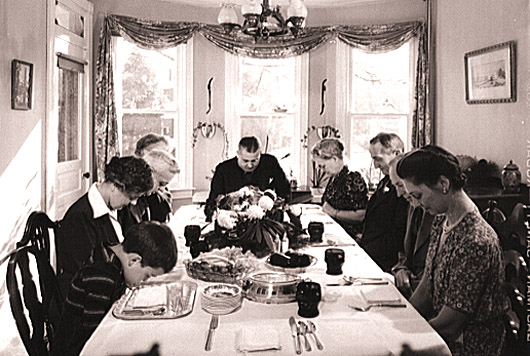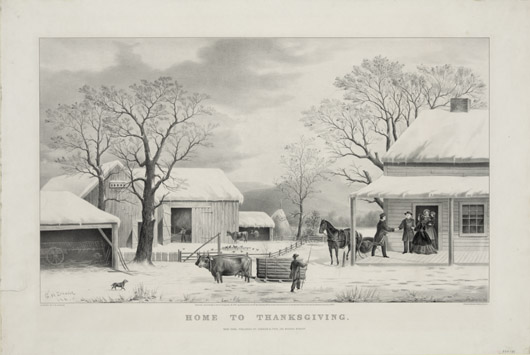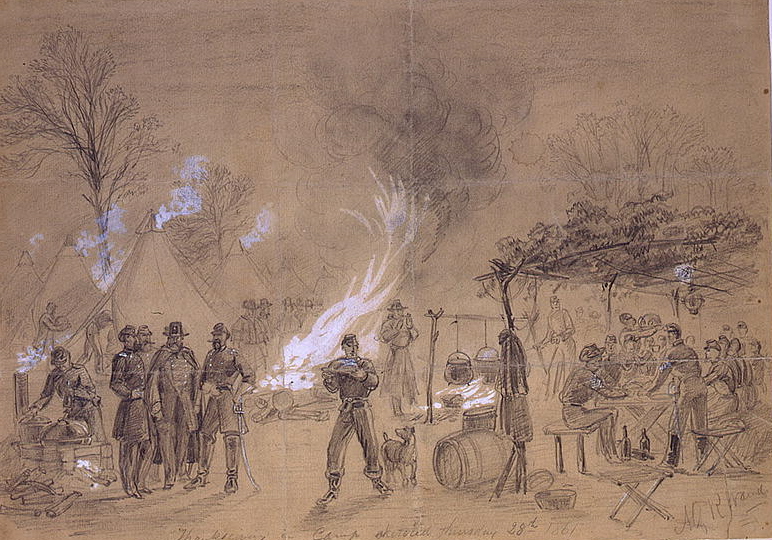FPI / November 28, 2019
A senior fellow at the Hudson Institute, Melanie Kirkpatrick has written and spoken often about the significance of Thanksgiving Day. Following are selected excerpts:
Charity: Americans have a long tradition of individual giving on Thanksgiving. George Washington, in 1789, donated beer and hot meals to imprisoned debtors in New York. During the Civil War on Thanksgiving Day 1864, hundreds of small donations made it possible for five hundred wounded and sick soldiers at Armory Square Hospital in Washington, D.C. to enjoy a Thanksgiving dinner.

Football: Football and Thanksgiving have gone hand in hand since the 1870s and probably earlier. No less an authority than the father of American football, Walter Camp, notes that “in America, the first football was a peculiar Thanksgiving Day custom of kicking an inflated pig’s bladder about the ‘yard’ of New England farmhouses, to the great merriment of the younger members of the household and the occasional discomfiture of the elders.”
Hospitality: An eye witness account to the first thanksgiving meal notes that the Wampanoag tribe, led by Chief Massasoit, “went out and killed five deer,” which they “bestowed on our Governor [Bradford], and upon the Captain.” The generous gift of five deer would provide enough meat to feed the large group for several meals.
Thankfulness: Ronald Reagan was the first president to mention Native Americans in his Thanksgiving Day proclamation and their traditions of giving thanks, which “antedated those of the new Americans.” His 1984 proclamation quoted a Seneca Indian prayer: “Give it your thought, that with one mind we may now give thanks to Him our Creator.” Obama paid tribute in 2011 to the Wampanoag “for generously extending their knowledge of local game and agriculture to the Pilgrims.” He urged Americans to “take this time to remember the ways that the First Americans have enriched our Nation’s heritage.”
* * * *
The following excerpts are from a speech by Melanie Kirkpatrick delivered on Oct. 18, 2016, at Hillsdale College’s Allan P. Kirby, Jr. Center for Constitutional Studies and Citizenship in Washington, D.C.
Just about every country has a national day — a holiday when citizens stop to honor their constitution or celebrate a monarch’s birthday or recall their day of liberation from colonial rule. The United States isn’t unique in celebrating its Independence Day. But Thanksgiving is something else. Only a few other countries set aside a day of thanksgiving. Most of these are harvest festivals, celebrations that trace their origins back to when life beat to the rhythm of the agricultural cycle.

America’s Thanksgiving holiday is something different. We live in a less religious age than did the Pilgrims. But it would be a mistake to claim, as some do, that Thanksgiving is not religious. It is that rarest of religious holidays, one that all religions can celebrate. The Pilgrims came to our shores seeking freedom to worship as they pleased. On Thanksgiving, Americans of all faiths — and of none — can give thanks that they found it.
Thanksgiving has grown up with the country. Many of our greatest historical figures are associated with it: George Washington, who proclaimed our first national Thanksgiving amid controversy over his constitutional power to do so — and who included in his proclamation Americans of every faith; Abraham Lincoln, who wanted to heal a war-torn nation when he called for all Americans, North and South, to mark the same day of Thanksgiving; and Franklin Roosevelt, who set off a national debate when he changed the holiday’s traditional date.
Ordinary Americans played their part too: Sarah Josepha Hale, the 19th-century magazine editor who campaigned to make Thanksgiving a national holiday; the New England Indians who boycotted Thanksgiving in the 1970s, calling it a day of mourning; and the 92nd Street Y in New York City, which recently launched Giving Tuesday, following in the long American tradition of remembering the poor and needy around Thanksgiving.
Thanksgiving says a lot about Americans. It reflects our national identity as a grateful, generous, and inclusive people. When an American takes his place at the Thanksgiving table or volunteers at a local food bank he is part of a continuum that dates back to 1621, when the Pilgrims and the Wampanoag Indians sat together for three days to share food and fellowship. The friendly coexistence between the English settlers and the Native Americans would last only a few decades longer. But that original Thanksgiving pointed the way to the diverse people we have become. …
There are two eyewitness accounts of the first Thanksgiving, written by Pilgrims William Bradford and Edward Winslow — although I should stipulate that the word “thanksgiving” does not appear in them. If you could travel back to 1621 and ask a Pilgrim to define “Thanksgiving Day,” his answer might surprise you. For the Pilgrims, “days of thanksgiving” were not marked by feasting, family, and fellowship — the happy hallmarks of the holiday we now celebrate — but by religious observance. They were called to express gratitude to God for specific beneficences such as successful harvests, propitious weather, or military victories. For the Pilgrims and other early immigrants to our shores, a “thanksgiving day” was set aside for prayer and worship.

From the Pilgrims’ perspective, their first Thanksgiving in New England took place two years after the event we recall as the first. It was July 1623, and the governor declared a day of thanksgiving in gratitude for rainfall that had saved their harvest. These religious days, observed in all 13 colonies, were the most direct influence on the development of Thanksgiving as we celebrate it today. …
Moving to the 18th century, the story of the political controversy surrounding our first Thanksgiving as a nation speaks volumes about our civil and religious freedoms. [A vigorous debate in 1789 over a resolution concerned whether the federal government or states had the authority to proclaim a day of Thanksgiving.] In the end, the resolution passed. It moved to the Senate, which quickly approved it, and on October 3, President Washington issued his now-famous Thanksgiving Proclamation. He designated Thursday, November 26, 1789, as “a day of public thanksgiving and prayer.” He did not decree a Thanksgiving. Rather, cognizant of the limits of his power, he asked that the governors of the 13 states comply with his request. He also made it clear that Thanksgiving was an inclusive holiday — not just for Christians but for Americans of every faith.
The next president to designate a day of national thanksgiving for general blessings was Lincoln in 1863. That’s not to say Americans did not celebrate Thanksgiving during the intervening years. They did. By the time of the Civil War, just about every state had established an annual day of thanksgiving. The holiday was celebrated by a day off from work, attendance at religious services, and, usually, a festive family gathering. The date was set by the individual governors, who sometimes coordinated but usually didn’t. The result was that while most states celebrated in November, a few marked the day in October or early December.
The story of how Thanksgiving became a regular national holiday is itself a classic American story of how an enterprising individual with a good idea can have an impact. In this case, a penniless young widow from New Hampshire, Sarah Josepha Hale, rose to become the editor of the most popular magazine of her era, Godey’s Lady’s Book, and used that position to generate grassroots support for a national Thanksgiving.

Mrs. Hale’s genius as an editor was to focus on American topics and American authors at a time when other magazines typically reprinted articles pirated from English publications. She used every feature of her magazine — editorials, short stories, recipes — to encourage the celebration of Thanksgiving. At the same time, she conducted a letter-writing campaign to presidents, governors, congressmen, and other influential figures.
In 1863 — in the midst of what is arguably the bloodiest year in American history — Lincoln, inspired by a letter from Mrs. Hale, took the extraordinary step of naming a national day of thanksgiving. He called on every American, North and South, to celebrate Thanksgiving “with one heart and one voice.” Following Washington’s example, he set Thanksgiving for the last Thursday of November. Lincoln’s 1863 proclamation was the first in an unbroken string of annual Thanksgiving proclamations by every subsequent president up to the present day. It is regarded as the beginning of our national Thanksgiving holiday.
But there remained a snag. While the overwhelming majority of governors went along in their state proclamations with the dates that Lincoln and later presidents designated, they were under no obligation to do so. The president’s proclamation had no force of law outside the District of Columbia and U.S. territories. That would require an act of Congress. For that, the country would have to wait until 1941. …
While researching my book, I met with teenagers attending Newcomer’s High School, a high school for immigrants in the borough of Queens in New York City. I led discussions in three classes about the Thanksgiving holiday, which most of the students were about to celebrate for the first time.
These high schoolers had a personal understanding of the Thanksgiving story. For them, the Pilgrim story was their story, and the Pilgrim fathers and mothers were historical reflections of themselves. The Pilgrims had been divided into two groups: those who came to the New World seeking religious freedom and those who came here seeking better lives. The same was true for these students.
A girl from Ivory Coast explained how her father had worked as a houseboy in the old country. Now, she proudly told me, he has a job with the Metropolitan Transit Authority. “My dad came here to have a better life,” she said.
A boy from Tibet, a country that hasn’t formally existed since China annexed it in 1950, explained that his family couldn’t practice the Buddhism of the Dalai Lama in China. But here in America they could do so without fear.
Talking to these students, I was reminded of the words of the late historian Samuel Eliot Morison, who called the Pilgrims “the spiritual ancestors of all Americans, whatever their stock, race, or creed.”
Shades of the Pilgrims and the Wampanoag Indians sit at every American’s Thanksgiving table, along with those of Washington, Lincoln, Sarah Josepha Hale, and others who have enriched our Thanksgiving tradition and helped to knit us together as a nation. This history, and more, is worthy of our remembrance, with grateful hearts, on every Thanksgiving Day — including this one.
